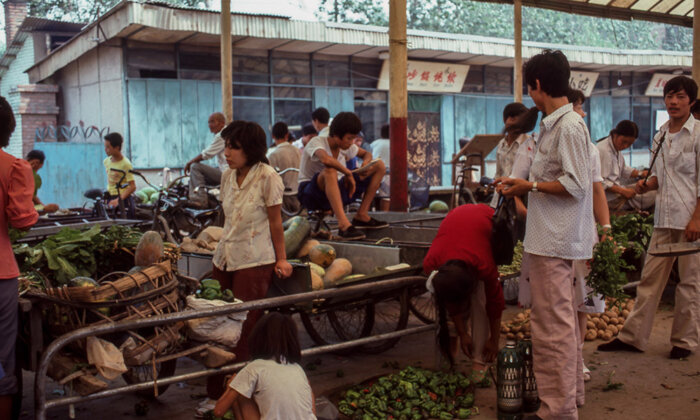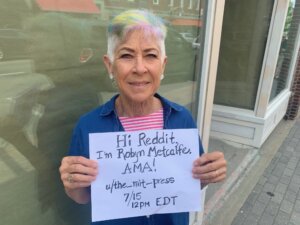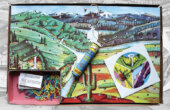Ask Me Anything: 12 Questions for Food Historian and Futurist Robyn Metcalfe

Robyn Metcalfe is a source of knowledge on everything from London’s 19th-century meat markets to the evolution of the New York pizza slice. She’s also the author of the book “Food Routes: Growing Bananas in Iceland and Other Tales from the Logistics,” which explores an often-overlooked aspect of the global food system: how food moves from producer to consumer.
In July, Metcalfe took part in Reddit’s popular “Ask me Anything” (AMA) series — a forum that allows regular users to chat with scientists and sitting presidents alike — to answer questions about the past and future of our food systems. Below, you’ll find a sample of those exchanges; the entire discussion can be read here.
1) Would a robotic hydroponic farming system be a viable major food source in the next thirty years? If so, are there any vegetables, grains, or fruits that cannot easily be cultivated by robots?
Robyn Metcalfe: I think it will be a food source, although viability depends on many factors: Will there be a way to scale those systems in a way that will lower the costs to make those harvests affordable to more than five percent of the population? And, crops such as bananas, avocados, and others may not be suitable for hydroponics in the long run. We may see specialized hydroponic greenhouses that will need to be fine-tuned for specific crops. That means we’re back to monocrops that would be vulnerable to contamination. The robots are here, but many will not be working in hydroponics.
2) What’s something you think few people today know about food markets of the past?
R.M.: That they operated in severely contaminated spaces. Meat markets of the 19th century and early 20th century operated with offal and blood in the streets. Food was often modified in order to get higher prices: chalk added to milk, meat polished with fat to appear fresh. A wonderful book about an old food market is Emile Zola’s “Belly of Paris.”
3) A question about accuracy in films. What films do you think accurately portrayed eating habits, cooking and food sales over the years? I’m thinking of films like Perfume, Babette’s Feast and in some ways the series Taboo.
R.M.: I love “Babette’s Feast.” It is one of the few films about food that allow the human connection with food to come through. Many films promote the filmmakers’ specific viewpoint — anti-GMO, meat, Big Food, local — but rarely do we see a film that is telling the stories about humans and their relationship to food on a more fundamental basis. Identity, meaning, social gathering.
4) Meat vs. lab meat vs. plant meat. Thoughts? Have we ever in history faced anything similar?
R.M.: We’ve experienced big changes in our food in periods such as the Industrial Revolution (technology transformed the distribution of food), and just after WWII, when factories and technologies combined to make what we now call the industrial food system. Now, we seem to be on the cusp of a big change, but there hasn’t been time for consideration of tradeoffs and consequences such as the impact of removing animals from the landscape. How will regenerative farming co-habitat with a world that wants it all… Meatless protein and sustainable farming on the soil?
5) Do you have any ideas for how we can tackle “food deserts” in American cities moving forward?
R.M.: If we could lower the costs and raise the convenience of healthy food, then more of it could be sold in cities. If vertical farms could scale in such a way that they could produce a greater variety of produce at a competitive cost, then markets could move closer to city dwellers. It’s not likely that we will see people growing their own food as a long term solution.
6) How was the food supplying system affected during severe pandemics in the past and how that compares to nowadays? I mean, how do you think that our current systems would react if we had a large scale pandemic?
R.M.: This is an interesting question and one that reveals some of the weaknesses in our global food system as it exists. Food logistics are good at adapting to change, even sudden change. Not exactly a pandemic, but when the Fukashima reactor crisis occurred, Japanese consumers sought new sources of fish and protein. Imports increased, fishermen were out of work, and it took years to readjust to norms or even to establish new norms. Watch the developments around Brexit as the UK struggles to adapt both to uncertainty and to the effects of disruptions in the food supply.

7) How do you see the global food market in 50 years, and how do you think climate change will affect this market?
R.M.: Climate change is one of the most significant factors in the design of our future food system. The cost of fuel, production of fuel, warming climates, the impact of changes on the agricultural landscape all point to new ways to transport food, new types of food, and new ways to produce food in different places. The food system is a system (I know, obvious), but those who want to improve it relative to climate change should look at the entire system when developing solutions. This is a big topic.
8) I’m fascinated by Garum, the popular fermented fish sauce that was extremely popular in the Roman/Mediterranean world. What are the closest modern analogues? Could I try making it myself? Why did its popularity fall? From what we know from the historical record that was insanely popular. I’m just surprised we don’t hear/see more about it!
R.M.: Garum is certainly cool and has a long history. Eventually, garum evolved into ketchup for the West as it appealed more to Western palates. Fermentation is going through a renaissance in the West now and I would imagine there are good garum-like sauces out there. See what you can find in those groups since all you need is some stinky fish to get started. I’m sure the smell of garum is off-putting to many Americans and they have difficulty adopting it to American recipe ingredient lists.
9) I find people don’t have time for restaurants and rather not eat fast food. Are food trucks the futures dining choice? Also any advice for a chef in training?
R.M.: Food trucks can provide a solution for food deserts, but can’t serve large populations in dense cities. Trucks are a great way to move around and find consumers and to test out new food concepts. But convenience and trust will be the main drivers for our future food system. This means consumers will continue to want fast food, just better food served quickly and anywhere. If I were a chef in training, I’d look at ways that technology could replace processing and prep in my kitchen and for a way to create food as an experience, personal, with a story. This is a tall order.
10) When defining the parameters for a sustainable agricultural sector what practices have persisted but need to go away?
R.M.: Fertilizers and chemical insecticides have certainly persisted, mainly because of the emphasis on increasing production per acre. These two practices seem to be in line for change due to consumer pressure and increased awareness of the impacts on us and our environment. The problem is that the global population will continue to grow and we have a limited amount of space for food production. So the pressure on production continues and will need cost-effective solution to keep output increasing and inputs decreasing. Precision ag is helping and we will likely see more crops that are engineered to solve these issues.
11) Do you think industrial-scale insect farming will become a major food source in the near future?
R.M.: In some countries, maybe. When I talk to a startup that has a bug factory in the business plan I wonder about how they plan to scale their business. The public is just too wary of the environmental impacts of a potential release of swarms, worms, or other insects. Locusts, for example. The need to produce insects at scale is a tough argument to make. Some countries are more incentivized to solve for this concern than the U.S. and bug protein source may grow in such regions as in Asia where bug-eating is normal. Bugs are a pretty good protein source.
12) What is the weirdest/most uncomfortable food practice you’ve found in your studies?
R.M.: There are certainly examples of people who eat live bugs or fish, which I find pretty unappetizing. But the Turducken craze and ways of stuffing one animal with another, then another seem both weird and uncomfortable.



